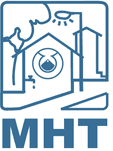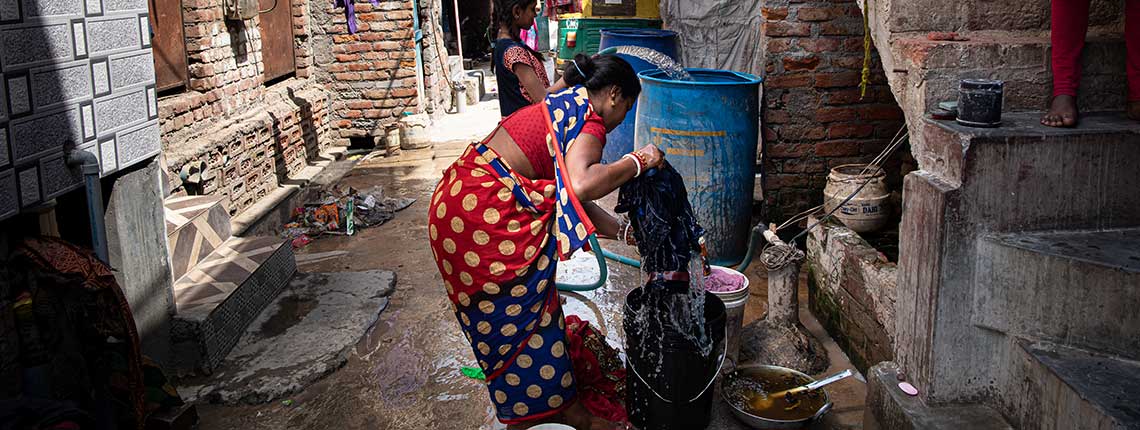 The Indian government’s Public Distribution System (PDS) shops have always played a critical role in addressing food insecurity in urban poor communities India. Ration cards issued through the PDS are like food stamps issued to each family, which entitle them to a fixed amount of food on a monthly basis. During the COVID-19 crisis, this government scheme played an important role in the delivery of relief and crucial extra support was often provided by community leaders, such as those involved in community action groups promoted by Mahila Housing Sewa Trust (MHT).
The Indian government’s Public Distribution System (PDS) shops have always played a critical role in addressing food insecurity in urban poor communities India. Ration cards issued through the PDS are like food stamps issued to each family, which entitle them to a fixed amount of food on a monthly basis. During the COVID-19 crisis, this government scheme played an important role in the delivery of relief and crucial extra support was often provided by community leaders, such as those involved in community action groups promoted by Mahila Housing Sewa Trust (MHT).
In settlements like Savda Ghevra on the outskirts of Delhi, community action groups (CAGs) were essential partners in the provision of relief during the COVID-19 crisis. A CAG represents about 250 households in a settlement and consists of 8-12 women leaders. The leaders are chosen from and by community members and their responsibilities include awareness building, networking and collaborating with local government officials on the implementation of schemes, and advocating for their communities’ demands. CAG members are vital links between their communities and local government institutions. The Housing Trust works with community members to provide support in identifying leaders, building capacity through training on issues that affect their community, facilitating engagement with officials and by helping the action groups with troubleshooting when needed.
During the COVID-19 crisis, one of the first things the CAGs did was to address the panic created by the sudden imposition of the nation-wide lockdown. They helped to prevent hoarding and worked to ensure access to food for all community members entitled to rations under the government scheme during the pandemic. They also helped to disseminate timely information to the community about the scheme. CAG leaders created a system for the shops that provided the rations, to ensure that every family received their groceries that social distancing was maintained at the distribution centers.
However, this relief was accessible only to those with ration cards that show that they are residents of Delhi. A majority of informal workers in the city are migrants and do not have ration cards. The Delhi government, in an effort to alleviate the situation for migrants during the lockdown, introduced e-coupons for those who did not have ration cards. In Savda Ghevra, the CAGs immediately created lists of those families who were eligible for the e-coupons and applied on their behalf through the government’s e-portal. CAGs acted as facilitators for community members without either the knowledge or means to access digital portals.
Along with providing dry rations, the government began distributing cooked meals as the issue of hunger became more pronounced. The local government school was used as the distribution center and two daily meals were provided to each person. Here too, the partnership with the CAGs became essential for the implementation of this scheme. The CAGs organized residents who lined up to collect food and ensured all protocols were adhered to during the process. In certain blocks of Savda Ghevra, the CAG leaders themselves went door-to-door to distribute meal packets to persons with special needs on a daily basis.
Even as these partnerships with various stakeholders grew, the CAG leaders remained focused on assuaging the anxieties and distress of fellow community members. A few families did not have access to the services of the PDS shops or e-coupons, as they lacked the proper documentation. In response, the CAG leaders got together and pooled their resources to purchase staples for these families–evidence of their connection to the community and the commitment to help them. Many CAG leaders paid for these out of their own pocket, despite their own financial struggles.
Through these various stories runs a common thread: the drive and commitment of the CAG leaders to take action and serve their communities. But more importantly, the CAG leaders demonstrate the critical role of grassroots organizing to provide a bridge linking communities with critical information, emotional and moral support, and government schemes and programmes. During this global pandemic, these linkages have directly contributed to the efficacy and efficiency of life-saving government relief.
Community action groups have been essential to ensure the efficient, effective and inclusive distribution of relief, mainly through their unique position to recognize and understand the needs of the community and to connect with relevant stakeholders. Because CAGs, such as those supported by MHT, have all-women leadership, they are also gender- sensitive, bring the community together, develop partnerships and networks, and safeguard the most vulnerable. They are essential bridges between the community and the ‘outside’ world.
Mahila Housing Sewa Trust (MHT) is a long-time partner of WIEGO’s Delhi Focal City team.
Photo: A resident of Savda Ghevra washing clothes in the narrow lane outside her home.
Credit: Rashmi Choudhary
